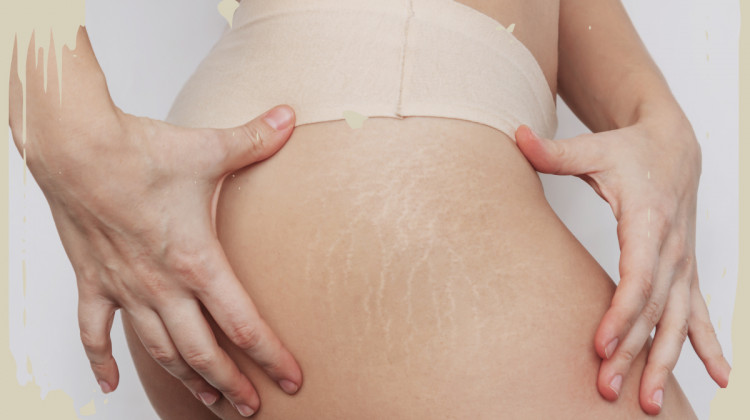
Working out regularly provides immense health and fitness benefits, but it can also lead to unsightly stretch marks if you're not careful. Stretch marks form when the skin is stretched excessively, causing the middle layer of skin (the dermis) to tear. This allows the deeper skin layers to show through, resulting in visible scar-like lines on the skin.
While genetics does play a role, there are many precautions you can take to minimize your risk of developing stretch marks from your workout regime. With some diligent skincare and healthy lifestyle habits, you can keep your skin strong, supple and free of marks.
Moisturize Daily
Keeping your skin well-hydrated is one of the most important things you can do to prevent exercise-induced stretch marks. When skin is dry it loses elasticity, making it more prone to tearing from muscle-building activities. Get into the routine of applying lotion after every shower or bath, especially to areas more likely to develop marks like upper arms, thighs, hips, butt and breasts.
Look for thick, nourishing lotions and creams containing ingredients like cocoa butter, shea butter, olive oil and coconut oil. Even basic drugstore brands like Aveeno or Lubriderm work well. Massage the moisturizer in thoroughly so it absorbs down to deeper layers of the dermis. This not only provides surface-level hydration but boosts the overall health of your skin. And consider adding specific skin-enhancing supplements like biotin, silica or collagen. Looking for the best collagen supplements available in the UK? Check out this detailed review of top collagen brands and product

Slowly Increase Exercise Intensity
One of the quickest ways to earn yourself some new stretch marks is pushing too hard too soon with your workouts. When you rapidly ramp up activities like weightlifting, sprinting, gymnastics or martial arts where muscles are expanding, you risk overstretching the skin before it has time to adapt. This causes those small dermal tears that turn into marks.
That’s why it’s critical to take a patient, gradual approach when you’re new to a rigorous training regimen. Slowly increase weight, sets, reps and intensity over a period of weeks and months. This gives your skin time to reinforce itself to better handle the expanding muscles and athletic movements underneath.
Wear Supportive Compression Clothing
The right workout clothing can go a long way towards stretch mark prevention. Compression leggings, tops and shorts provide gentle pressure against the skin that helps guard against overstretching. The snug fit and stretchy fabric limits how far and fast your skin can be pulled during exercise.
Compression clothing also improves circulation, bringing more oxygenated blood and nutrients to skin tissue. This assists with collagen production and cell regeneration, enhancing overall skin health and strength. Just be aware that compression wear can get very warm. Look for breathable, sweat-wicking fabrics when possible.

Stay Hydrated
Proper hydration is vital for keeping your entire body in top working condition, including your largest organ - the skin. Drinking plenty of water each day helps in multiple ways to strengthen skin against stretch marks. First, hydration plumps up skin cells giving them increased elasticity and flexibility. Well-hydrated skin is simply more resilient against damage.
Water also delivers essential nutrients to skin tissue. This fuels growth of collagen and elastin, compounds that provide structural support and integrity. Finally, adequate hydration ensures toxins flow out efficiently rather than building up in cells and damaging skin. Aim for the recommended eight 8-ounce glasses of water per day minimum.
Dehydration can also make you more prone to irritating skin rashes like underboob rash, which is common among active women. Be sure to read up on prevention and treatment if you're experiencing chafing or rashes.
Fuel Your Body with Nutrients
What you eat has a profound impact on the health and vitality of your skin. Make sure your daily diet contains plenty of vitamins, minerals and nutrients vital for optimal skin elasticity and regeneration. Antioxidants like vitamins C, E and A combat free radicals that degrade skin cell walls. Zinc stimulates collagen production while proteins are the building blocks of strong connective tissues. Essential fatty acids keep cell membranes supple and hydrated.
Some nutrient-rich foods to regularly incorporate include citrus fruits, leafy greens, avocados, salmon, nuts, seeds, olive oil and beans. Taking a daily multivitamin can help cover any nutritional gaps. And consider adding specific skin-enhancing supplements like biotin, silica or collagen. Always check with your doctor before starting any new supplement, especially if you have underlying medical conditions

Exfoliate Your Body
Sloughing away dead skin cells through regular exfoliation enables lotions and oils to better absorb down into viable skin layers. This maximizes their moisturizing and nourishing benefits. Exfoliation also smooths rough skin patches and minimizes the flaky skin that can crack and tear more easily when stretched.
You can exfoliate in the shower with a scrubby glove, loofah or body brush. Use gentle circular motions and avoid aggressively rubbing fragile skin. Focus on target areas like hips, thighs, stomach and breasts where stretch marks are most likely to develop. Be extra careful exfoliating any existing marks so as not to cause further damage.
Use Targeted Massages
Massaging problem zones where stretch marks tend to form can be helpful for prevention. Using circular motions, gently massage moisturizing oils or lotions into upper arms, thighs, hips, butt, stomach and breasts. Even just 5-10 minutes per area several times a week can make a difference.
Massage boosts blood flow delivering nourishing oxygen, vitamins and minerals into skin tissue. This stimulates collagen production to fortify and rejuvenate skin cells. The direct pressure and motion helps reduce the appearance of existing marks and improves overall skin elasticity in those vulnerable areas

Manage Your Weight
Trying to lose weight too rapidly can definitely set the stage for new stretch marks. When your body sheds fat quickly, the skin doesn’t have sufficient time to shrink down along with your leaner physique. This creates loose, sagging skin more susceptible to damage.
Aim for a steady, gradual weight loss of about 1-2 pounds per week through healthy eating and regular activity. This allows skin to naturally tighten as you slim down. Drink plenty of water to help flush out fat. And be sure to replace sagging skin’s lost fat layers with some good muscle tone through strength training. Building muscles gives skin more structural support.
Know When to Scale Back
Make sure you listen to warning signals from your body during workouts. Sharp pains, cramps, lightheadedness and dizzy spells can all be signs you need to ease up and modify your routine. Pushing through when your body says no is a recipe for injury and skin damage.
Be prepared to quickly stop an activity if you feel any alarming discomfort or pain. Better to momentarily scale back intensity or duration than to suffer a major setback from injury that could leave you sidelined for weeks. Stretch marks simply require slowing your pace and being patient as your fitness level gradually improves.
Live a Healthy Lifestyle
Your overall lifestyle and health habits have a big influence on skin vitality and elasticity. Make sure you’re getting adequate sleep since tissue regeneration occurs during rest. Manage stress through yoga, meditation and other relaxation techniques. Quit smoking which can degrade collagen and elastin. Eat a clean, whole foods diet and steer clear of junk food.
Building lean muscle through resistance training provides underlying support that protects skin and keeps it taut. But let common sense and moderation guide your workouts, not vanity. While some marks may be unavoidable as your fitness improves, the right prevention approach can help minimize their appearance.

Be Diligent With Your Skincare Routine
Consistency is key when it comes to caring for your skin. Stretch mark prevention is not a one-time effort, but rather an ongoing skincare mission. Your habits around hydrating, massaging, strengthening and protecting your skin need to become second nature for them to be truly effective.
Make your skincare routine part of your everyday life just like eating right and working out. Set reminders if needed to apply moisturizers and exfoliate regularly. Check in periodically with problem zones through massage. And be sure to tweak your regimen if you notice any new marks forming. Your skin will thank you for the diligence.
Consult a Dermatologist if Needed
If you still notice stretch marks forming despite your best prevention efforts, don’t hesitate to check in with a dermatologist. A skin specialist can assess your marks and provide personalized advice based on factors like your skin type, health history and workout regimen.
Dermatologists can recommend prescription-strength topical creams that stimulate collagen growth and repair damaged skin. They can also offer professional skin treatments like microneedling, laser therapy or chemical peels that reduce the appearance of existing stretch marks. Detecting problems early gives you the best chance of effective treatment.
Stretch marks may be an inevitable side effect of pumped up workouts for some people. But with diligent skincare, a gradual fitness approach, proper hydration and healthy nutrition you can minimize their occurrence and maintain smooth, strong skin as you get fit. Be patient and listen to your body, and those unsightly marks don't have to hold you back from reaching your fitness goals.













